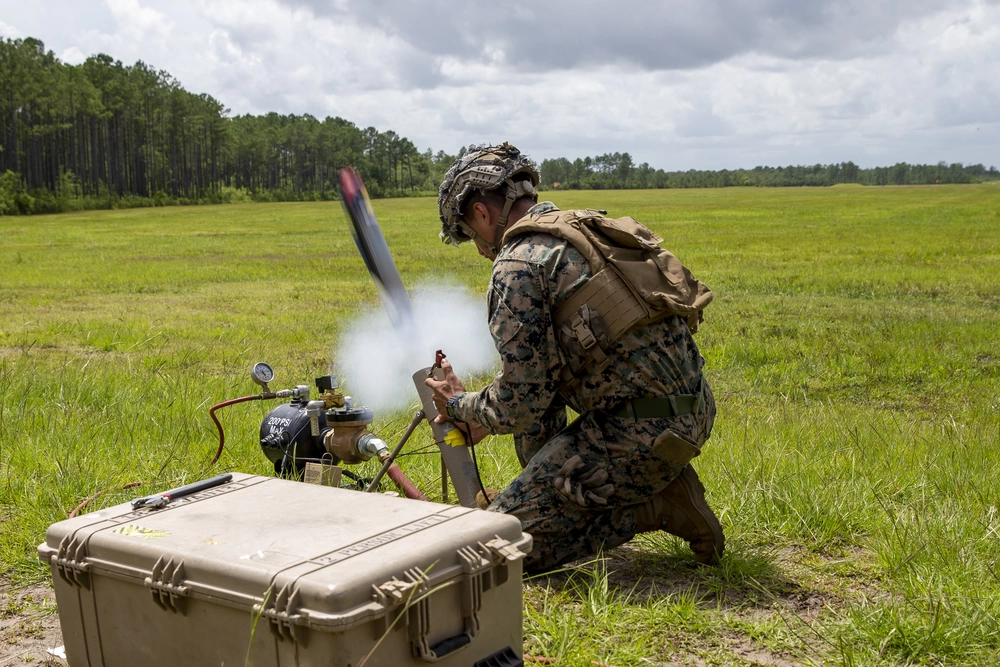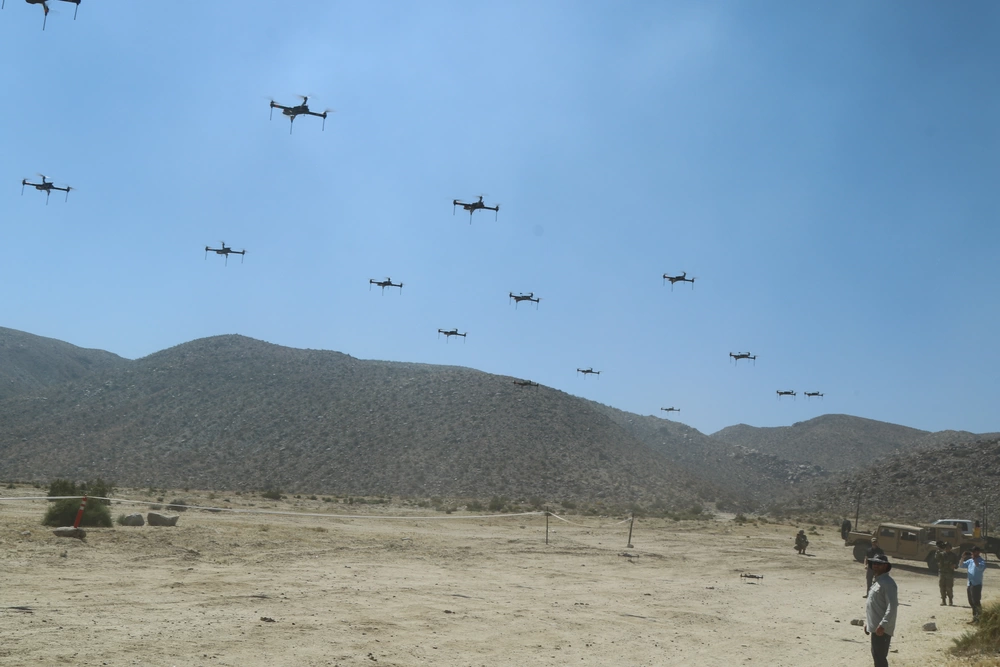Army and Marines embrace kamikaze drones for ground combat
- By Hope Seck
Share This Article

Loitering munitions, or kamikaze drones, have become a key weapon in modern warfare. Both Russia and Ukraine employ them, using both military-grade versions and the much cheaper first-person view (FPV) commercial options costing as little as a few hundred dollars.
And while the U.S. ground services have long sounded a call for counter-drone weapons to protect forces, equipment, and installations, they are now moving to acquire offensive drones that infantry troops can wield.
The purpose and design of kamikaze drones is contained in the name: they’re intended for one-way trips, built at a scale and efficiency that permits their single-use function. Also known as loitering munitions, they can hover on station or in a set area until a target is designated. Then, they crash into that target, taking it out and destroying themselves in the process, just like the Japanese suicide fighters of World War II.
The Marine Corps was the first to go on drone offensive earlier this year, announcing the formation of its Attack Drone Team, a nine-Marine crew tasked with figuring out how to integrate first-person view weaponized drones into infantry formations. Yet, when the team was announced at the end of March, few specifics about the kinds of drones the Corps would acquire for this effort were released, other than that the models would cost less than $5,000 each.
In written testimony before the House Armed Services Committee, though, Lt. Gen. Eric Austin, the Corps’ deputy commandant of Combat Development and Integration, revealed more about the service’s plans for loitering munitions.
“One-way attack (OWA) drones may not necessarily fit into the [small unmanned aerial systems] category, but their integration into our formations will be essential,” Austin told the committee ahead of a May 1 hearing. “Programs like the Low-cost Uncrewed Combat Attack System (LUCAS) are providing the Marine Corps with lower-cost long-range fires options and leveraging the lessons learned in Ukraine and Israel.”

LUCAS is a program the Corps has not yet made public beyond Austin’s announcement. But his reference of one-way attack drones – another synonym for loitering munitions or kamikaze drones – emphasizes the place these systems will have in future warfare.
A spring article from the Marine Corps Warfighting Laboratory’s Futures Directorate outlined the process the “Joint FPV Working Group,” led by the lab, went through to find offensive drones suitable for U.S. infantry formations. One of the drones the group was able to get approved for government use was the Neros Archer FPV, an attack drone the U.S. has already sent to Ukraine by the thousands to support the country’s defensive fight. These same systems can be converted into loitering munitions, Forbes reported.
The Marine Corps is also charging ahead with an initiative it calls Organic Precision Fires-Light, described in solicitations as a “system designed to provide rifle squads and platoons with a man-packable organic, loitering, precision strike capability to engage the enemy beyond the line of sight.” Teledyne FLIR Defense received a contract in 2024 worth $249 million for a vertical take-off and lift loitering munition as part of the Organic Precision Fires-Light initiative.
The Army, which also contracted last year to buy Switchblades for dismounted infantry units, released a “call for solutions” on the government’s contracting website this month, announcing it was looking to quickly prototype what it’s calling “Low Altitude Stalking and Striking Ordnance.” or LASSO.
Army budget documents call for more than $120 million to procure the yet-to-be-selected LASSO systems, and budgeting documents, as reported by DefenseScoop, describe a semi-autonomous, man-portable system with a range of about 12 miles, capable of loitering, attacking a target, and aborting on short notice if the human in the loop needs to call off the mission.
Related: Air Force has revealed world’s first two AI-piloted fighter drones

The requirement for a human to abort the drone on short notice is significant: The Army and Marine Corps embracing of loitering munitions in ground combat represents a concession of some control, as troops on the ground usually hold and aim with the weapons they deploy against the enemy. Kamikaze drones can be made capable of autonomously identifying relevant targets based on inputs and criteria, and the technology can, in theory, even be made to operate with full autonomy, making kill decisions once targets are identified.
The Ukrainian military claims Russia is already using these kinds of drones, and has alleged that they make no distinction between military targets and civilian infrastructure like a street bus.
However, outside analysis is more tentative about these systems, with Stacie Pettyjohn writing for War on the Rocks last year that the vast majority of attack drones being employed in the conflict are human-controlled.
“There are signs that Ukraine and Russia are working on developing fully autonomous drones, but these have not been widely fielded – likely because they are not yet effective,” Pettyjohn writes.
As the technology matures, the U.S. military may find itself operating within self-imposed limits regarding ethical use of autonomy while its adversaries observe no such limits. But these drones are only as effective as the trust the Soldiers and Marines on the ground place in them. And, as Pettyjohn notes, development of trust, particularly with a new weapons system, is a gradual process.
One future scenario she envisions would pair an unarmed drone for target acquisition with an armed drone tasked by a human with eliminating the target.
“As artificial intelligence matures, fully autonomous drones may be fielded in the future. But it would likely be a more incremental process that keeps a human in or on the loop and allows soldiers to refine and develop trust in the system,” Pettyjohn said.
Feature Image: U.S. Soldiers from various units across Europe assemble a Switchblade 600 during the culminating event of their Loitering Munitions Training at the Grafenwoehr Training Area, Germany, Nov. 4, 2024. This was the first time U.S. Soldiers launched Switchblade 600s, a loitering munition system, in Europe. (U.S. Army Photo by Sgt. Cody Nelson)
Read more from Sandboxx News
- Germany to help Ukraine produce a ‘significant’ number of long-range missiles
- Russian nuclear bases exposed in enormous intelligence leak
- Poland’s FB Beryl is a rifle between worlds – Service rifles from around the world
- Hermeus Quarterhorse Mk 1 takes flight marking a big step toward fielding world’s fastest jet
- US Navy receives its 250th MK49 RAM air defense system, the last line of defense of many of its ships
Related Posts
Sandboxx News Merch
-

‘Kinetic Diplomacy’ Bumper Sticker (White)
$8.00 Add to cart -

F-35 ‘Evolution’ Framed Poster
$45.00 – $111.00Price range: $45.00 through $111.00 Select options This product has multiple variants. The options may be chosen on the product page -

A-10 ‘Warthog’ Poster
$22.00 – $28.00Price range: $22.00 through $28.00 Select options This product has multiple variants. The options may be chosen on the product page
Hope Seck
Hope Hodge Seck is an award-winning investigative and enterprise reporter who has been covering military issues since 2009. She is the former managing editor for Military.com.
Related to: Airpower

One tank to rule them all: Europe announces 11-country collaboration to build next-gen tank

Army seeks information about miniature aircraft that can take out drones
Sandboxx News
-

‘Sandboxx News’ Trucker Cap
$27.00 Select options This product has multiple variants. The options may be chosen on the product page -

‘AirPower’ Classic Hoodie
$46.00 – $48.00Price range: $46.00 through $48.00 Select options This product has multiple variants. The options may be chosen on the product page -

‘AirPower’ Golf Rope Hat
$31.00 Select options This product has multiple variants. The options may be chosen on the product page -

‘Sandboxx News’ Dad Hat
$27.00 Select options This product has multiple variants. The options may be chosen on the product page
